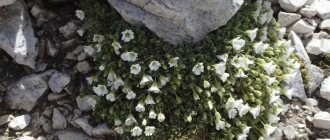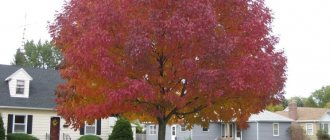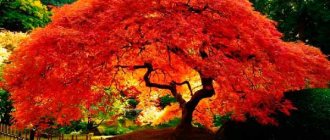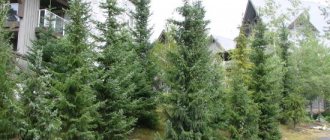Why do we need moss in the garden, many readers will think. After all, you can plant beautiful flowers that will decorate the space and improve the area of the pond. And moss in a garden plot is a useless curiosity. Such an opinion would be extremely erroneous. By underestimating the role of soft perfection in garden design, you can lose the opportunity to create an exclusive image, as if created by nature itself.
The culture of using bryophytes in landscaping has a long history. Back in the fourteenth century in Japan, the Saihoji Moss Garden was created by human hands, which still delights visitors with its beauty.
Saihoji Moss Garden
In the modern world, designers are increasingly using bryophytes when landscaping areas, creating unique, soft images.
Specific Features
In nature, there are hundreds of thousands of varieties of bryophytes that lack a root system. Rhizoids, thin thread-like processes, are responsible for continued growth. These amazing creatures are equipped with stems and small leaves. Their colonies love damp, shaded places, forming emerald edges.
By mixing different subspecies, they achieve the image of a changing collage of various shades. A lovely rug becomes a backdrop for violets, lilies of the valley, saxifrage, and hostas.
With the arrival of cold weather, the velvet meadow does not lose its beauty; it does not require fertilizers, haircuts and is not afraid of temperature changes.
Plant lifespan
Decorative moss is the prerogative of eco-style fans. Making your home or neighborhood greener improves your mood and well-being. With proper care, the jewelry will retain its attractiveness for up to 10 years.
If moss is not properly cared for, it rarely lasts longer than 2-3 years. The three main factors affecting the lifespan of mosses are humidity, lack of sunlight and temperatures above +4 degrees. If these conditions are met, the mosses will grow as long as possible.
Varieties
Of the numerous species, flowering moss is suitable for landscaping, usually represented by:
- Leucobria with convex cushions.
- Awl-shaped phlox with pink, purple, white flowers.
- Cuckoo flax with columnar shoots.
- Dicranum with small protuberances.
- Sphagnum, loosening the soil.
Perennials have multi-colored petals, patterned crowns, and boxes similar to real fruits. Some resemble algae and mushrooms together.
Types of moss
Leukobria grafts well in partial shade on sandy soil. The slightly convex velvet pads of this moss have the ability to absorb sound and can create a special atmosphere in areas intended for relaxation in the garden.
Hypnosis moss grows equally well on the ground and on stones. It can also grow in partial shade, which significantly expands its scope of application.
Kukushkin flax, or polytrichum, from the genus of deciduous mosses, is found in swampy forest areas, near myceliums. It has tall stems reminiscent of flax shoots and brown-colored boxes.
A low dicranum with a feathery bright green cover is valued by designers for decorating vertical surfaces. It grows at the foot of trees in coniferous forests.
Fern moss lives up to its name, being located in shady areas of the garden, it creates dense thickets reminiscent of the openwork patterns of fern leaves.
Peat moss shoots create a blooming carpet in many shades of pink and green. It grows well in sandy soils near water.
The photo shows several ideas for using decorative moss to decorate lawns and alpine slides.
Areas of application
The valuable properties of moss have elevated it to the rank of a favorite design raw material. Due to its unpretentiousness to soil and light, it can be grown in spots where other greenery has no chance to survive. In addition, a dense blanket is a serious barrier to weeds.
The long-liver lives on stones, so a fashionable technique in landscape art is mossy sculptures, borders, fountains, thresholds, emphasizing the pristine aesthetics of antiquity.
The unusual appearance of the specimens helps to recreate magnificent lawn ensembles and alpine slides. The checkerboard pattern looks very impressive when light and dark patterns alternate, the design of ponds and the bases of deciduous and coniferous trees.
There is a demand for decorating buildings with non-standard living canvases that cleanse the atmosphere of carbon dioxide and nitrogen, while the moss on the wall does not spoil or destroy it.
Moss in the garden: benefit or harm, it’s hard to give a clear answer
The independent appearance of different plant species does not always bring joy to the owners. Often these include a variety of lichens that appear along the trunks of garden trees. There are differences between them.
True mosses (bryophytes, lat. Bryophyta) are studied by the science of bryology and classify them as low-growing plants with no root system. It is replaced by epidermal outgrowths or rhizoids. Through them, plants are attached to the soil, stones, and tree trunks. They quickly settle into the garden, creating favorable conditions for many pests and insects.
In order not to worsen the appearance of the garden (by creating sloppy, shaggy trees), it is necessary to be able to properly use an ornamental plant and control its growth in planned compositions, taking into account its biological properties.
The role of true mosses for the functioning of ecosystems is very great. Their ability to absorb and retain moisture helps regulate water balance and reduce soil erosion. Sphagnum helps the formation of peat among bogs. The bactericidal and antiseptic properties of the plant prevent the appearance of rot and the development of harmful bacteria. The ability to increase soil acidity helps gardeners grow orchids and violets among mature apple trees, pears. Bee houses are insulated with sphagnum moss. Weeds do not grow among the dense carpet. The most commonly grown moss is “cuckoo flax”.
However, having appeared along the trunk of one tree, moss plants reproduce by spores and quickly become the “master of the garden.” At the same time, the conditions for the development of fruit trees and their fruiting deteriorate due to the lack of air access to the branches. The increased ability of the soil to increase acidity and form waterlogged soil properties harms the development of many vegetable plants.
Regular procedures for reducing soil acidity are required, for example, using wood ash. For the winter, it is recommended to whiten the trunks of garden trees with a solution of lime (3 kg of lime is required per bucket of water). The solution consists of copper sulfate, mullein, and clay. For large areas occupied by interfering moss, spring treatment with iron sulfate is used.
However, decorative moss is different from real moss.
Growing
To get a fluffy cover, buy ready-made store-bought samples or use strips dug from the nearest forest. In the latter case, it is necessary to select mature representatives that will not be harmed by transportation and planting.
They are dug up and carefully taken out with the original layer without damaging the roots. Bryophytes like the western and northern sides; direct sun is destructive for them, but from small morning portions the color becomes richer.
Planting on a slope will require fixation to prevent sliding from rain flows. Experts say that it is better to plant vegetation in the fall. It is first washed with water and the following measures are carried out:
- The site is cleared of turf, debris and loosened.
- A substrate is placed in the recess, which includes peat, black soil, and forest soil.
- The prepared piece is placed with pressure and watered.
- The bushes are planted at a distance of 25 cm.
Miniature islands ideally coexist with sorrel, lingonberry, conifers, and lichens. It will take a couple of years until full-fledged mossy areas appear.
During the first month, the plantings require constant moisture.
Marvelous paintings
With a special composition you can draw original graffiti. To do this, prepare moss with your own hands by placing the following components in a blender:
- two handfuls of washed plants;
- kefir a third of a glass;
- sugar a teaspoon;
- flower hydrogel 3 tablespoons.
Beat the mixture until it becomes a paste consistency. Having outlined the outline of the design, or using a stencil, it is applied to a stone or concrete surface. Both horizontal and vertical planes serve as a landing bridge. It is important that the surface structure is porous and rough.
A thick layer guarantees a thick edge.
Classification of mosses
Mosses prefer shade and dampness, which is explained by their method of feeding and reproduction. Plants grow filamentous processes (rhizoids) that replace roots. And with their help they absorb water. The main part of the plant is not divided into stems, leaves, roots and is called thallus (thallus), or moss body. Mosses differ in color, structure, and places of distribution, but regardless of the species, they all reproduce by spores.
During sexual reproduction of mosses, water is extremely important, since it is thanks to moisture that the sperm of male plants reach the eggs of female plants and fertilization occurs. The female plants then develop a sporangium, a capsule in which the spores mature. When the spores germinate, they form a thread-like structure. The threads develop into female and male plants.
After fertilization of the female gamete, an asexual generation called sporophytes develops. Sporophyte is a capsule with spores on a long stalk. An asexual sprout lives off of gametophytes, that is, plants that have sex. In all types of mosses, there is a clear alternation of asexual and sexual generations, that is, an alternation of the development of sporophytes and gametophytes.
Mosses also reproduce vegetatively. With this option, part of the adult plant separates and begins to develop independently near the “parent”, covering the wet soil with a continuous carpet.
Anthocerotaceae
Anthocerotaceae have long been considered by botanists as a separate class. Now they are called bryophytes, which have a thallus structure similar to mosses. There are about 300 species of anthocerotes. The bryophytes themselves have a thallus in the form of rosettes, in which rhizoids develop on the underside. Sporangia grow from the rosettes, resembling a pod in appearance. Bryophytes are inhabitants of the tropics and subtropics; only a few species are common in temperate climates. For example, Anthoceros laevis, which appears after weeding in beds and flower beds, loves cracks and grooves on garden paths.
Hepatic
Representatives of the liverwort class are found more often in the tropics than in temperate climates. The variety of plants is enormous. There are at least 6 thousand species that are characterized by vegetative propagation. Some species, such as Riccia floating, do not attach to trees, soil, or boulders, but drift freely in fresh water bodies. In the wild, Riccia floating grows in the Far East. Aquatic species are grown in aquariums.
In Central Russia, marchantia is common, spreading along the soil. Outwardly, it resembles a multilayer branching plate 10 cm thick. Liverworts include: spherocarpus, merchia, symphyogyne, pallavicinium, riccia, metzgeria, hymenophytum.
Leafy
The most numerous class, accounting for 95% of all types of mosses, is divided into 3 subclasses: sphagnum, brie, and andreaceae. All deciduous species are common in forest and swampy areas of the middle zone and north. The most famous are: sphagnum, leukobria, cuckoo flax (green moss).
The Sphagnum subclass is widespread throughout the world. There are about 300 species, 40 of them grow in Russia. They are distinguished by the white-green color of their shoots, sometimes with a brown or reddish tint. They prefer the tundra zone. They are of particular value because peat deposits are formed thanks to sphagnum.
Peat mosses (there are more than 120 species) grow in a continuous carpet in swamps. The annual growth of shoots is 2 cm. The lower layer dies off, but does not succumb to rotting processes. Carbolic acid produced by the moss body is antiseptic and prevents decomposition. Peat is formed through a very slow process. According to experts, the formation of 1 meter of peat deposits takes 1 thousand years. The most common types: bog sphagnum, brown, Magellan, papillous.
The subclass Brievae is numerous, numbering more than 14 thousand species, about 1300 are found in the vastness of Russia. Plants are mostly perennial, their height varies from 1 mm to 50 cm. Briaceae have traditionally green shades; there are representatives of red-brown or almost black color. They prefer the forest zone of central Russia, where they spread along the ground and germinate on rotting trees and leaves. The most famous species are: cuckoo flax, brium pilosa.
The subclass Andreeves is the smallest group - only about 120 species. Adreeves are inhabitants of the Arctic and Antarctic. In harsh climatic conditions they grow on rocks and stones, forming velvet pads. The most striking representatives are: glaucous leucobrium, red and yellow splachnum, centipede dicranum.
Places of distribution
Moisture-loving plants are found in all corners of the earth, except for salty waters (seas, oceans, lakes) and saline soils. Despite their slow growth (on average, the growth of one plant per year is 1-2 mm), mosses form a significant part of the biomass of the entire planet. The wide distribution of plants is explained by their ability to grow on nutrient-poor soils.
Interior use
Growing bryophyte at home is a rather labor-intensive process; you will need to spray it every half hour and wait for growth for several years. But there is a way out - stabilized moss, which brings natural charm to the apartment.
In natural material, a specialized liquid stops its development; it is flexible, changes color, but is in a coma state, acting as a competitor to indoor flowers.
Breathing slabs do not need watering or lighting, they promise:
- Excellent sound insulation from neighbors in multi-storey buildings.
- Controls room humidity by absorbing moisture from the air.
- Low maintenance requirements.
This is a decoration of interior walls and furniture in eco-style, which does not hold back the flight of imagination. It is not forbidden to add vines and ferns to the panels.
Moss crafts in the form of rugs, frames and other accessories are very popular.
There is a way to create a faux similar product using green acrylic paints and chopped green sponge mixed with clear glue. This mass is distributed on the surface, imitating a velvety “fur coat”.
The aesthetic and practical advantages of a non-trivial culture have made it an indispensable element of landscape design, transforming garden plots and urban housing before our eyes. It fits colorfully into any outdoor composition, requiring no care and maintaining its attractiveness in any season, which is clearly confirmed by photos of decorative moss.
What is decorative moss
Decorative moss is a natural material that has been suspended in development. That is, to form compositions from decorative moss, ordinary moss is used, in a state that is similar to a coma. The water is replaced with a special liquid that stops all plant development processes. Thanks to this, moss acquires new, special qualities that are used for decoration.
For example, the tone of the paint changes, it becomes brighter and can be maintained throughout its entire service life. Decorative moss is also flexible, unlike natural moss, which is very free-flowing when dry.
This moss is hypoallergenic, meaning it cannot harm people, animals or others. Despite the preservation method, it is a completely environmentally friendly material, because it is natural.
However, many people use ordinary bryophytes to decorate their garden. At the same time, we must not forget about their benefits and harms, which are described above.











